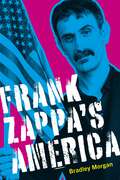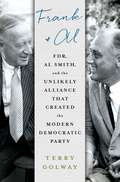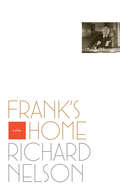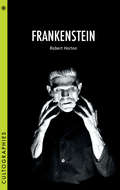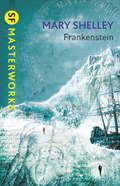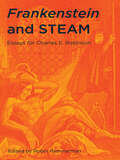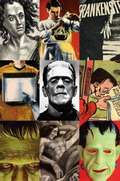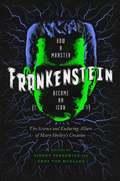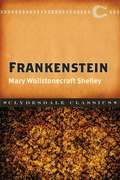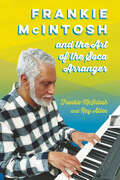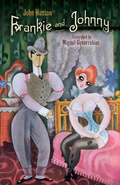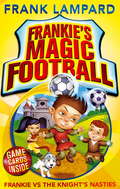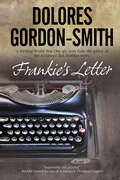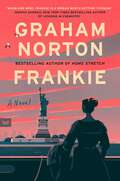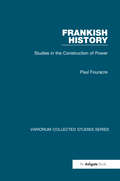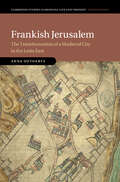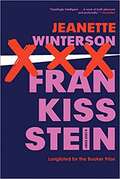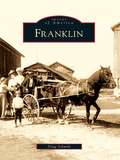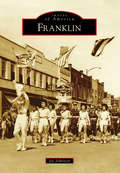- Table View
- List View
Frank Roney, Irish Rebel and California Labor Leader: An Autobiography
by Ira B. CrossThis title is part of UC Press's Voices Revived program, which commemorates University of California Press’s mission to seek out and cultivate the brightest minds and give them voice, reach, and impact. Drawing on a backlist dating to 1893, Voices Revived makes high-quality, peer-reviewed scholarship accessible once again using print-on-demand technology. This title was originally published in 1931.
Frank S. Matsura: Iconoclast Photographer of the American West
by Michael HollomanA captivating collection of Native American portraiture by early 20th-century Japanese photographer Frank S. Matsura frames the rarely told story of his work and unique personal life.Frank S. Matsura (1873-1913) was an immigrant photographer, a local hero, a charismatic original, an enigma, and a man of the community whose legacy has grown over time. Today, historians are still compiling the details of Frank’s unconventional life, and his identity and images are enjoying a revival. An expansion of academic scholarship, documentaries, exhibitions, and regional historical interests, particularly regarding his Native American portraiture, has resulted in a more vivid understanding of the man and his work: Matsura’s photographs of local tribal members reveal an honesty and empathy, a counterpoint to the contrived or nostalgic seen in his contemporaries’ images from the same period. His oeuvre of just ten years (due to his unexpected passing from tuberculosis) documents everyday local events and the cacophony of characters who visited his studio for dime portraits. There are parallels to be found between Matsura’s work and today’s society in attempts to rise above anti-Asian bias, the continued pursuit of cultural agency, and a desire to individually define what America can and should be. Along with beautifully reproduced black-and-white photographs, the book features narratives from five scholars who give life and context to Matsura’s work, celebrating his captivating photography as a look into immigrant artists, American identity, and the history of a fluid and multicultured exceptionalism.THE FIRST COMPREHENSIVE BOOK OF ITS KIND: Frank Matsura was a Japanese-born photographer who lived in northern Washington State in the early 20th century. This is a rare and comprehensive exploration of his life, including the juxtaposition of his work against the images of Native American people by American photographer Edward S. Curtis. MATSURA'S SINGULAR WORK AND STYLE: Matsura’s work broke many cultural and photographic taboos of the time. He took candid and relaxed photos of his subjects, including local Native American tribes. Many of his images were spontaneous group photos of locals in character and costume. He included himself in many of his photos, and he included interracial couples in his images as well. A HIDDEN FIGURE WHOSE TIME HAS COME: This collection was based on a 2023 exhibit at the Northwest Museum of Arts and Culture. Interest in Matsura’s work has gained momentum over the years, and this book coincides with the release of Emmy Award–winning filmmaker Beth Harrington’s documentary Our Mr. Matsura on his work and legacy.Perfect for: American and Native American history buffs Photographers and artists Fans of Frank Matsura's unconventional story and work Lovers of vintage, historical, and portrait photography
Frank Zappa's America
by Bradley MorganFrom his early albums with the Mothers of Invention, Frank Zappa established a reputation as a musical genius who pushed the limits of culture throughout the 1960s and 1970s, experimenting with a blend of genres in innovative and unheard-of ways. Not only did his exploratory styles challenge the expectations of what popular music could sound like, but his prolific creative endeavors also shaped how audiences thought about the freedom of artistic expression. In Frank Zappa’s America, Bradley Morgan casts the artist as an often-misunderstood figure who critiqued the actions of religious and political groups promoting a predominantly white, Christian vision of the United States. A controversial and provocative satirist, often criticized for the shocking subject matter of his songs, Zappa provided social commentary throughout his career that spoke truth to power about the nefarious institutions operating in the lives of everyday Americans. Beginning in the late 1970s, his music frequently addressed the rise of extremist religious influence in American politics, specifically white Christian nationalism. Despite commercial and critical pressure, Zappa refused to waver in his support for free speech during the era of Reagan and MTV, including his pointed testimony before the U.S. Senate at the Parents Music Resource Center (PMRC) hearings. Throughout the 1980s, and until his death in 1993, Zappa crafted his art form to advocate for political engagement, the security of individual liberties, and the advancement of education. Music became his platform to convey progressive views promoting the rights of marginalized communities most at risk in a society governed by the principles of what he perceived as Christian radicalism. Frank Zappa’s America examines the musician’s messaging through song, tracing the means by which Zappa created passionate, at times troubling, art that combats conservativism in its many manifestations. For readers in the twenty-first century, his music and public advocacy demonstrate the need to preserve democracy and the voices that uphold it.
Frank and Al: FDR, Al Smith, and the Unlikely Alliance That Created the Modern Democratic Party
by Terry Golway"This is history told the old-fashioned way. The book is only as long as it needs to be, the adroit narrative full of heroes (Smith, Roosevelt, big-city Democratic bosses) and villains (William Randolph Hearst, William Jennings Bryan, the Ku Klux Klan). The scenes are vivid and the anecdotes plentiful." —The Wall Street Journal"Frank & Al is the latest of Mr. Golway’s several captivating books on New York politics. He delivers once again, with a timely narrative on the centennial of Smith’s first election as governor." —The New York Times "The tangled, tragic story of Al Smith and Franklin Roosevelt is one of the great tales of American politics, and Terry Golway has told it beautifully. This is a joyous book... an especially important book now." —Joe Klein"I highly recommend this fascinating and enlightening book." —Franklin D. Roosevelt, III"Beautifully written...The book is must reading for anyone interested in the history of American politics and the rise of the country’s welfare state." —Robert Dallek, author of An Unfinished Life: John F. Kennedy, 1917-1963“A marvelous portrait... Highly recommend!” —Douglas Brinkley, author of Rightful Heritage: Franklin D. Roosevelt and the Land of AmericaThe inspiring story of an unlikely political partnership—between a to-the-manor-born Protestant and a Lower East Side Catholic—that transformed the Democratic Party and led to the New DealIn the late 19th and early 20th centuries, the Democratic Party was bitterly split between its urban machines—representing Catholics and Jews, ironworkers and seamstresses, from the tenements of the northeast and Midwest—and its populists and patricians, rooted in the soil and the Scriptures, enforcers of cultural, political, and religious norms. The chasm between the two factions seemed unbridgeable. But just before the Roaring Twenties, Al Smith, a proud son of the Tammany Hall political machine, and Franklin Roosevelt, a country squire, formed an unlikely alliance that transformed the Democratic Party. Smith and FDR dominated politics in the most-powerful state in the union for a quarter-century, and in 1932 they ran against each other for the Democratic presidential nomination, setting off one of the great feuds in American history. The relationship between Smith and Roosevelt, portrayed in Terry Golway's Frank and Al, is one of the most dramatic untold stories of early 20th Century American politics. It was Roosevelt who said once that everything he sought to do in the New Deal had been done in New York under Al Smith when he was governor in the 1920s. It was Smith who persuaded a reluctant Roosevelt to run for governor in 1928, setting the stage for FDR’s dramatic comeback after contracting polio in 1921. They took their party, and American politics, out of the 19th Century and created a place in civic life for the New America of the 20th Century.
Frank's Home
by Richard Nelson"A thoroughly invigorating, tightly focused piece of Chekhovian drama, wherein chatter about work and art . . . fail to mask deep vulnerability."-Chicago TribuneA play about Frank Lloyd Wright set in the summer of 1923, when the great architect has recently left Chicago for California, hoping to mend his relationship with his adult children. Richard Nelson brings to life two great architectural demigods, Wright and Louis Sullivan, only to show their all-too-human frailties.Richard Nelson's plays include Rodney's Wife, Goodnight Children Everywhere, Some Americans Abroad, Franny's Way, New England, and James Joyce's The Dead (with Shaun Davey), winner of the Tony Award for Best Book of a Musical.
Frankenstein (Cultographies)
by Robert HortonJames Whale's Frankenstein (1931) spawned a phenomenon that has been rooted in world culture for decades. This cinematic Prometheus has generated countless sequels, remakes, rip-offs, and parodies in every media, and this granddaddy of cult movies constantly renews its followers in each generation. Along with an in-depth critical reading of the original 1931 film, this book tracks Frankenstein the monster's heavy cultural tread from Mary Shelley's source novel to today's Internet chat rooms.
Frankenstein (S.F. MASTERWORKS)
by Mary ShelleyBrilliant, driven Victor Frankenstein has at last realised his greatest ambition. The scientist has succeeded in creating intelligent life. But when his creature first stirs, Frankenstein realises he has made a monster. And, abandoned by its maker and shunned by everyone who sees it, the Doctor's creation sets out to destroy him and all that he holds dear.Mary Shelley's FRANKENSTEIN remains one of the greatest horror stories ever written, a book that chillingly captures the unforeseen terror of playing God. And the heart-stopping fear of being pursued by a powerful, relentless killer.
Frankenstein and STEAM: Essays for Charles E. Robinson
by Brian Bates Susan J. Wolfson Mark A. McCutcheon Lisa Crafton Siobhan Watters Lisbeth Chapin L. Adam Mekler Robin HammermanCharles E. Robinson, Professor Emeritus of English at The University of Delaware, definitively transformed study of the novel Frankenstein with his foundational volume The Frankenstein Notebooks and, in nineteenth century studies more broadly, brought heightened attention to the nuances of writing and editing. Frankenstein and STEAM consolidates the generative legacy of his later work on the novel's broad relation to topics in science, technology, engineering, arts, and mathematics (STEAM). Seven chapters written by leading and emerging scholars pay homage to Robinson's later perspectives of the novel and a concluding postscript contains remembrances by his colleagues and students. This volume not only makes explicit the question of what it means to be human, a question Robinson invited students and colleagues to examine throughout his career, but it also illustrates the depth of the field and diversity of those who have been inspired by Robinson's work. Frankenstein and STEAM offers direction for continuing scholarship on the intersections of literature, science, and technology. Published by the University of Delaware Press. Distributed worldwide by Rutgers University Press.
Frankenstein's Monster
by J. S. BarnesA writer finds his rural English life disrupted by the arrival of a mysterious doctor with a legendary past in this bold and chilling sequel to Frankenstein, written in the style of Mary Shelley's classic.From the author of Dracula&’s Child. Perfect for fans of Kim Newman and Silvia Moreno-Garcia."He was soon borne away by the waves, and lost in darkness and distance."There are those who would swear that Victor Frankenstein is dead. Those who would swear that his Creature died also.They are wrong.1842. Folklorist Nathaniel Greene escapes to the country to finish his latest book, along with his wife, Alice. Yearning for a family, and yet finding herself without, Alice watches as Greene grows ever more distant with her, fraying their already tense bonds. When a mysterious stranger arrives on their doorstep, bedraggled and delirious, Alice welcomes him in, finding herself seduced by the promises he makes.1850. In Newgate prison, Nathaniel Greene stands accused of murder. Philanthropist Jesse Malone and psychic Hubert Crowe are determined to understand what happened, but the story Greene has to tell is almost unbelievable: one of monstrous, impossible creations made in an outhouse laboratory.To uncover the truth behind Greene&’s bizarre claims, the two investigators must delve into a terrifying world where the men play God once more, and the ghosts of the past appear to be alive and vengeful.In this visionary sequel to Mary Shelley&’s peerless classic, old experiments resume, new mysteries arise, and the true question of mankind&’s morality is tested once more.
Frankenstein: A Cultural History
by Susan Tyler HitchcockFrankenstein began as the nightmare of an unwed teenage mother in 1816 in Geneva, Switzerland. When the moral universe was shifting and advances in scientific knowledge promised mankind dominion over that which had been God's alone, Mary Shelley envisioned a story of human presumption and its misbegotten consequences. Now, two centuries later, that story is constantly retold and reinterpreted, from Halloween cartoons to ominous allusions in the public debate, capturing and conveying meaning central to our consciousness today and our concerns for tomorrow. From Victorian theater to Boris Karloff with neck bolts, to invocations at the President's Council on Bioethics, the monster and his myth have inspired everyone from philosophers to philatelists. This is a lively and eclectic cultural history, illuminated with dozens of pictures and illustrations and told with skill and humor. Susan Tyler Hitchcock uses film, literature, history, science, and even punk music to help us understand the meaning of this monster made by man.
Frankenstein: How A Monster Became An Icon: The Science And Enduring Allure Of Mary Shelley's Creation
by Sidney Perkowitz Eddy Von MuellerFew creations have risen from literary origins to reach world-wide importance like Frankenstein. This landmark volume celebrates the bicentenary of Mary Shelley's creation and its indelible impact on art and culture. The tale of a tormented creature created in a laboratory began on a rainy night in 1816 in the imagination of a nineteen-year-old Mary Wollstonecraft Shelley, newly married to the celebrated Romantic poet Percy Shelley. Since its publication two years later, in 1818, Frankenstein: Or, the Modern Prometheus has spread around the globe through every possible medium and variation. Frankenstein has not been out of print once in 200 years. It has appeared in hundreds of editions, perhaps more than any other novel. It has inspired a multitude of stage and screen adaptations, the latest appearing just last year. “Frankenstein” has become an indelible part of popular culture, and is shorthand for anything bizarre and human-made; for instance, genetically modified crops are “Frankenfood.” Conversely, Frankenstein’s monster has also become a benign Halloween favorite. Yet for all its long history, Frankenstein's central premise—that science, not magic or God, can create a living being, and thus these creators must answer for their actions as humans, not Gods—is most relevant today as scientists approach creating synthetic life. In its popular and cultural weight and its expression of the ethical issues raised by the advance of science, physicist Sidney Perkowitz and film expert Eddy von Muller have brought together scholars and scientists, artists and directions—including Mel Brooks—to celebrate and examine Mary Shelley’s marvelous creation and its legacy as the monster moves into his next century.
Frankenstein: Or The Modern Prometheus
by Mary Shelley"Enduring power.” -The New York TimesPackaged in handsome and affordable trade editions, Clydesdale Classics is a new series of essential literary works. The series features literary phenomena with influence and themes so great that, after their publication, they changed literature forever. From the musings of literary geniuses such as Mark Twain in The Adventures of Huckleberry Finn, to the striking personal narratives from Harriet Jacobs in Incidents in the Life of a Slave Girl, this new series is a comprehensive collection of our literary history through the words of the exceptional few.Frankenstein, or The Modern Prometheus, is often referred to as one the most important literary works of all time. Having been adapted and reprinted thousands of times, and often cited as the birth of the gothic novel and the science fiction genre, Frankenstein has captivated readers for centuries. It is the haunting tale of Victor Frankenstein, a young scientist who creates a grotesque and cognizant being through a scientific experiment. "The monster,” as it’s frequently referred to throughout the novel, consists of sewn body parts from multiple cadavers being used for scientific research. On a dark, stormy night, the creature is brought to life by being shocked with an electrical current harnessed from a lightning storm. The novel explores scientific practices such as galvanism, as well as the ethical repercussions of bringing the deceased back to life.With its grim, but gripping narrative, Frankenstein is the classic story of life and death, humanity and monstrosity, and blurring the lines in between.
Frankforce and the Defence of Arras 1940 (Battleground Dunkirk)
by Jerry MurlandThere is no other city in France that has the same associations in time of conflict that the British have with Arras. Since the campaigns of John Churchill, 1st Duke of Marlborough, in the early 18th century, British soldiers have fought in and around Arras, occasionally as an enemy but, more often, as defenders of French and Allied democracy. Battlefield visitors to the area will immediately recognize the names of towns and villages that were as significant to the men of Marlboroughs army as they were to those who fought in the First and Second World Wars.This book serves both as guide to the Second World War battlefields that surround the city and its environs as well as detailing the actions of the British armored attack of 21 May 1940. The book looks at the strategic situation that led up to the famous Arras counterstroke and, using material that has not been published before, examines the British and German actions between 20 and 23 May. The only Victoria Cross action that took place during this time is looked at in detail; as is the fighting that took place in Arras and during the breakout.Despite its shortcomings, the counterstroke achieved the essential element of surprise and caused widespread alarm amongst the German command and hit Rommels 7th Panzer Division at precisely the moment when his armored units were ahead of the infantry and gunners. The British infantry fought well and both the Durham battalions were fortunate that their commanding officers and senior NCOs were men who had already fought in one conflict and possessed the determination to rally their less experienced junior ranks and fight on regardless. Such was the case with the two tank battalions, although sadly they lost both their commanding officers and over half the tanks that went into the engagement. The attack did enable the British to tighten their hold on Arras albeit temporarily and, as is often cited, built doubts in the minds of German High Command as to the speed of their advance and contributed to the subsequent Hitler halt order of 24-27 May.The author has gone to some lengths to track down accounts from those individuals who served in the area during May 1940 and fought the enveloping tide of the German advanceThe book is supported by three car tours, one of which takes the visitor along the tragic path taken by the Tyneside Scottish on 20 May and two walking routes, which concentrate on Arras.137 black and white photographs (integrated) and a number of maps derived from regimental histories; and six tour maps provide the battlefield visitor with illustrations of the battlefields as they were in 1940 and as they are today.
Frankie McIntosh and the Art of the Soca Arranger
by Ray Allen Frankie McIntoshSoca music, an offspring of older Trinidadian calypso, emerged in the late 1970s and is now recognized as one of the English-speaking Caribbean’s most distinctive styles of popular vocal music. Frankie McIntosh and the Art of the Soca Arranger tells a story of Caribbean music in the diaspora through the eyes and ears of a pioneering soca arranger. A fascinating collaboration between Frankie McIntosh and music scholar Ray Allen, this cowritten memoir places the music arranger at the center of several overlapping narratives of immigration and musical diaspora.The book begins with McIntosh’s personal voyage from Saint Vincent to Brooklyn and his efforts to hammer out a career in music while raising a family in his newly adopted home. His immigrant tale is intertwined with his musical journey, from popular Caribbean dance bands through formal studies in Western classical music and jazz to his work as a gigging jazz pianist and calypso/soca arranger. Along the way he embraced the varied musics of New York’s African American and West Indian communities, working with such iconic calypsonians as the Mighty Sparrow, Lord Kitchener, Calypso Rose, and Alston “Becket” Cyrus. His story provides a unique lens for viewing Brooklyn Carnival music and brings into focus the borough’s rise to prominence as the transnational hub of the soca music industry in the 1980s.An alternative to traditional scholarship that tends to focus on calypso and soca singers, this work explores the instrumental dimensions of the art form through the life and music of one of the most celebrated soca arrangers and keyboardists of all time.
Frankie and Johnny
by John Huston Miguel CovarrubiasThe ill-fated lovers Frankie and Johnny were already legends by 1930, the year of this illustrated drama's publication. The unique interpretation is a collaboration between John Huston, the future director of The Maltese Falcon and other film classics, and Miguel Covarrubias, an influential painter and caricaturist. Huston, who reputedly interviewed a neighbor of the real-life Frankie and Johnny, was inspired to adapt the tale of love gone wrong for a puppet show for which George Gershwin supplied musical accompaniment. In addition to Huston's script and distinctive images by Covarrubias, this edition features the "Saint Louis Version" of the folktale, regarded as the most authentic version, as well as 20 variations on the story and song.
Frankie vs The Knight's Nasties: Book 5 (Frankie's Magic Football #5)
by Frank LampardFrankie and his team love playing football. There's always time for a game. And now that they have their magic football they're playing against teams they never imagined!So when Frankie, Louise, Charlie and trusty Max get sent back to medieval times they're going to have to beat the nastiest knights to get home.
Frankie's Letter
by Dolores Gordon-SmithThis WWI spy thriller &“packed with adventure, action, and unforeseen twists&” by the author of the Jack Haldean mysteries &“will appeal to Ken Follett fans&” (Booklist). It&’s 1915, and Dr. Anthony Brooke has been called away from his medical practice to spy for the British Crown. But now it seems his mission has been compromised. In a hotel in Kiel, Germany, a colleague&’s dying words are, &“There&’s a spy in England . . . Frankie&’s letter. Read Frankie&’s letter . . .&” But Anthony hasn&’t a clue who Frankie might be. With his cover blown and the German army at his heels, Anthony&’s search for the truth leads him to a seemingly innocent estate in the English countryside. Here, in the home of a British publishing magnate and his beautiful French wife, Anthony uncovers a web of spies, treachery, and terrorists as the war gets closer—and becomes all too personal. &“[An] exciting spy thriller full of period charm.&” —Kirkus Reviews &“Dolores Gordon-Smith keeps her plot twisting and turning.&” —Historical Novel Society
Frankie: A Novel
by Graham Norton"Warm and wise, Frankie is a woman worth getting to know."—Bonnie Garmus, New York Times-bestselling author of Lessons in ChemistryFrom the internationally bestselling author and host of The Graham Norton Show, a dazzling and decades-sweeping story about love, bravery, and what it means to live a significant life.Always on the periphery, looking on, young Frankie Howe was never quite sure enough of herself to take center stage—after all, life had already judged her harshly. Now old, Frankie finds it easier to forget the life that came before.Then Damian, a young Irish caretaker, arrives at her London flat, there to keep an eye on her as she recovers from a fall. A memory is sparked, and the past crackles into life as Damian listens to the story Frankie has kept stored away all these years.Traveling from post-war Ireland to 1960s New York—a city full of art, larger-than-life characters and turmoil—Frankie shares a world in which friendship and chance encounters collide. A place where, for a while, life blazes with an intensity that can’t last but will perhaps live on in other ways and in other people.
Frankish History: Studies in the Construction of Power (Variorum Collected Studies)
by Paul FouracreThe volume consists of sixteen papers on the history of Francia between the seventh and eleventh centuries. Originally published between 1979 and 2009, the papers are arranged around three interlinking themes: the relationship between History and Hagiography, the history of Francia under the respective regimes of the Merovingan and Carolingian kings, and the problem of how states with weak governing institutions were able to exercise power over large areas. The history of Francia has been one of the most productive areas of early medieval history over the past two generations. Models of European development have been based on its rich materials and the fact that the polity lasted for half a millennium makes it a prime area for the study of the dialectic between continuity and change. The papers collected here all have this ’big history’ as their background. It is to be hoped that keying into such questions makes them both accessible and useful for students and teachers alike.
Frankish Jerusalem: The Transformation of a Medieval City in the Latin East (Cambridge Studies in Medieval Life and Thought: Fourth Series)
by Anna GutgartsFocusing on Jerusalem under Frankish rule following the Crusader conquest of 1099, this book sheds light on the dynamic socio-economic factors that shaped Jerusalem's gradual urban transformation. In exploring the extensive corpus of medieval property records, it reveals that the growth of Jerusalem's monumental and symbolic landscape, as befitted its new status as the capital of the Latin Kingdom, was in tandem with more mundane facets of life in the city, such as growing residential settlement patterns, and the expansion of its rural hinterland. This places the history of Frankish Jerusalem in a broader theoretical framework by analyzing the socio-economic and institutional mechanisms – such as immigration and the formation of medieval trust – that shaped the cityscape during a particularly tumultuous period in its history, and places it against the backdrop of medieval urbanisation processes in other regions.
Frankissstein: A Love Story
by Jeanette WintersonSince her astonishing debut at twenty-five with Oranges Are Not the Only Fruit, Jeanette Winterson has achieved worldwide critical and commercial success as “one of the most daring and inventive writers of our time” (Elle). Her new novel, Frankissstein, is an audacious love story that weaves together disparate lives into an exploration of transhumanism, artificial intelligence, and queer love. <p><p> Lake Geneva, 1816. Nineteen-year-old Mary Shelley is inspired to write a story about a scientist who creates a new life-form. In Brexit Britain, a young transgender doctor called Ry is falling in love with Victor Stein, a celebrated professor leading the public debate around AI and carrying out some experiments of his own in a vast underground network of tunnels. Meanwhile, Ron Lord, just divorced and living with his mom again, is set to make his fortune launching a new generation of sex dolls for lonely men everywhere. Across the Atlantic, in Phoenix, Arizona, a cryogenics facility houses dozens of bodies of men and women who are medically and legally dead… but waiting to return to life. <p> What will happen when homo sapiens is no longer the smartest being on the planet? In fiercely intelligent prose, Jeanette Winterson shows us how much closer we are to that future than we realize. Funny and furious, bold and clear-sighted, Frankissstein is a love story about life itself.
Franklin
by Doug SchmidtFranklin is a microcosm of how a sparsely populated farming community may progress into a small city. German and Irish settlers established Franklin's earliest business enterprises--taverns, blacksmiths, farm supply stores, and the annual Labor Day fair, which remains the largest of its kind in Milwaukee County. In 1956, Franklin moved from a township to a city, featuring a single patrolman and an all-volunteer fire department. For entertainment, Franklinites availed themselves of the 41 Twin Outdoor Theater or Saturday night races at Hales Corner Speedway, Little League diamonds in St. Martins or behind the fire station, and dance halls at Heiden's or the White Dove. A new era began when Franklin High School opened its doors to 350 students in 1962. Today, at 36 square miles--Milwaukee's largest suburb--it is noteworthy that Franklin still has room for a functioning stone quarry and the Tuckaway Country Club.
Franklin
by Joe JohnstonStudents of the Civil War know Franklin, Tennessee, for the major battle that happened here, but there is a lot more to the story. In fact, Main Street in Franklin is a glimpse into 250 years of history. Within a few blocks surrounding the public square, some of the city's original buildings now house the newest and most popular shops, restaurants, and entertainment venues in Middle Tennessee. Franklin has been a center for agriculture and manufacturing. It is a place where families can enjoy small-town life on the interstate. It is home to a college. It has always been the seat of Williamson County. Franklin's small businesses have a habit of sticking around for decades, often passing through generations of the same family. Franklin is as quaint and picturesque as it is exciting and progressive, because it continues to attract the kind of people who have always made it that way.
Franklin
by Peter Greene Sarah Ann BentonOn December 4, 1753, Gen. George Washington traveled to the junction of the Allegheny River and French Creek during one of his military excursions. There, the settlement was called Venango but soon became known as Franklin. Established in the heart of the original oil country in the 1740s, Franklin is the seat of Venango County. Once referred to as "the Nursery of Great Men," it boasts a rich history of industry and railroads. Franklin's historic district, listed in the National Register of Historic Places, includes businesses that have been staples in the city for over 100 years, such as Feldman Jewelers and Anderson Furniture. Today, Franklin takes great pride in its history and heritage. Franklin's annual Applefest, the largest craft festival in western Pennsylvania, honors the travels of Johnny Appleseed, who planted his trees throughout the town during his journeys, and the bridge that spans the confluence of the Allegheny and French Creek is still known as Washington Crossing.


